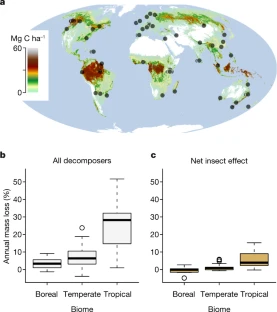Phys.org September 2, 2021
The amount of carbon stored in deadwood is equivalent to about 8 per cent of the global forest carbon stocks. The decomposition of deadwood is largely governed by microorganisms and insects contributing to variations in the decomposition rates. An international team of researchers from a number of countries including Germany and USA conducted a field experiment of wood decomposition across 55 forest sites and 6 continents to show that the deadwood decomposition rates increase with temperature, and the strongest temperature effect is found at high precipitation levels. As a net effect insects accelerate the decomposition in tropical forests. In temperate and boreal forests, they found weak positive and negative effects with a median mass loss of 0.9 per cent and −0.1 per cent per year, respectively. Globally, the net effect of insects may account for 29 per cent of the carbon flux from deadwood, which suggests a functional importance of insects in the decomposition of deadwood and the carbon cycle…read more. TECHNICAL ARTICLE

Decomposition rates and insect effects per biome. Credit: Nature volume 597, pages 77–81 (2021)